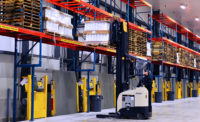How the Trucking Industry Handles Driver Retention

Driver retention is the No. 1 key challenge facing the trucking industry today. Find out how some trucking experts are overcoming this challenge, and what’s in store for the industry come 2015.
Food fraud, government mandates, on-time deliveries and Mother Nature are all pressing challenges impacting today’s trucking industry. However, it’s driver retention that trumps all challenges, forcing carriers to think outside of the boxcar in order to not only hire, but also keep good drivers. Trucking experts weigh in on how to overcome driver turnaround.
Shortage of truck drivers
The American Trucking Association (ATA), Arlington, Va., estimates that today’s U.S. carriers are short 30,000 truck drivers. In fact, driver turnover is the single largest challenge in the trucking industry, says Erik Neandross, chief executive officer of Gladstein, Neandross & Associates, consultants of energy and clean transportation based in Santa Monica, Calif.
“With driver turnover rates in the 80-100% range and sometimes higher, fleet operators are spending an enormous amount of time, energy and resources simply trying to find the drivers needed to keep their trucks on the road,” he adds.
To compound the problem, today’s drivers aren’t just drivers, according to Mike Roeth, executive director of North American Council for Freight Efficiency (NACFE) and trucking leader for the Carbon War Room.
“Drivers need to perform so many more functions now rather than just drive,” says Roeth. “Drivers continue to be a challenge, but the industry will find innovative ways to attract and retain drivers.”
Like other trucking companies, FST Logistics’ No. 1 challenge is retaining drivers.
“Our biggest challenge is driver hiring,” says Art DeCrane, chief financial officer for the Columbus, Ohio, company. “We, like every trucking company, are having difficulty finding qualified/quality drivers. Also, trying to keep drivers moving and not getting held up for hours delivering at food warehouses. We are continuing to work with shippers to improve the receiving processes particularly at food warehouses to speed up deliveries. Delays are causing challenges in getting multiple turns per week on a truck, thus causing increased costs to the company and lack of revenue to the driver. Food warehouses have to improve their receiving procedures.”
A white paper published by the American Transportation Research Institute (ATRI), Arlington, Va., highlights a challenging future for the trucking industry based on a dramatic shift in the age of the driver workforce. Analysis found that the trucking industry is disproportionately dependent on employees 45 years of age or older, many of whom will retire in 10-20 years.
“The average age of our current driver workforce is 52 and we’re noticing fewer and fewer younger individuals applying for jobs in recent years,” says Keith Tuttle, founder of Motor Carrier Service, Inc., Toledo, Ohio, and ATRI member. “If the industry doesn’t collectively figure out how to recruit younger drivers, we may not have anyone left to haul freight in the coming decades.”
New technologies for fleet optimization
Despite the trucking industry’s challenge to retain drivers, companies are developing new technologies designed to optimize fleet, manage drivers and provide energy efficient ways of moving goods cross country.
For example, the trucking industry’s investment in alternative fuels and energy efficient technologies reached an all-time high this last year, says Neandross.
For starters, a variety of alternative fuels, in-cab information technology systems and energy improvement systems help carriers better manage their fleet.
“From a variety of alternative fuels, all kinds of in-cab information technology systems and a huge array of efficiency improvement technologies, the level of technological innovation and adoption taking place right now in the fleet industry is absolutely unprecedented. There is certainly no one size fits all here,” he adds.
Alternative fuels, such as natural gas, propane autogas and electricity continue to gain more market share, while automated transmissions, aerodynamic fairings, 6x2 axles, tire pressure systems, anti-idling devices, GPS-connected systems, telematics solutions and more allow fleets to leverage analytics and big data to optimize their operations, provide feedback and train drivers, adds Neandross.
“In 2015, we will see an increased focus on efficiency improvement technologies and strategies of all kinds, in both traditional diesel-powered operations as well as those fueled by natural, propane, electricity and other alternatives,” he says. “As has often been said, the best alternative fuel gallon is one that is not burned. No matter the composition of the gallon, increased fuel efficiency will be the central theme for 2015.”
Likewise, NACFE released its 2014 Fleet Fuel Benchmark report, which shows a good deal of technologies are emerging that help fleets reduce fuel costs, automate transmissions, reduce idle time and more.
“We work with 11 fleets, growing to 15 next year, as to the various technologies they are buying on tractors and trailers. With this data, we have drawn adoption curves for 70 technologies for the past 11 years since 2003. These 11 fleets averaged 6.8 mpg in 2014, $7,200 per truck per year better in fuel expense than fleets similar to them that are not buying fuel efficiency technologies,” adds Roeth. “A move to electricity is key for this market—powering reefer units as well as cabs for loading and soon devices on the truck itself allowing variable operation.”
Furthermore, shippers need to pay better attention to maintaining those cold temperatures while in transport, says DeCrane.
“We continue to update our TMS system to fit with our customers’ demands and requests. We are also starting to work with mobile technology for tracking products through the chain. We built a CNG station at one of our facilities, and are adding more CNG equipment to our fleet,” he adds.
Regardless of the challenges, trucking continues to be the most economical and reliable means to move cold products throughout the country.
“It’s really quite simple—trucks are the only way to bring refrigerated product exactly to where it needs to be,” says Neandross. “There is simply no other way to get the job done.”
Looking for a reprint of this article?
From high-res PDFs to custom plaques, order your copy today!









